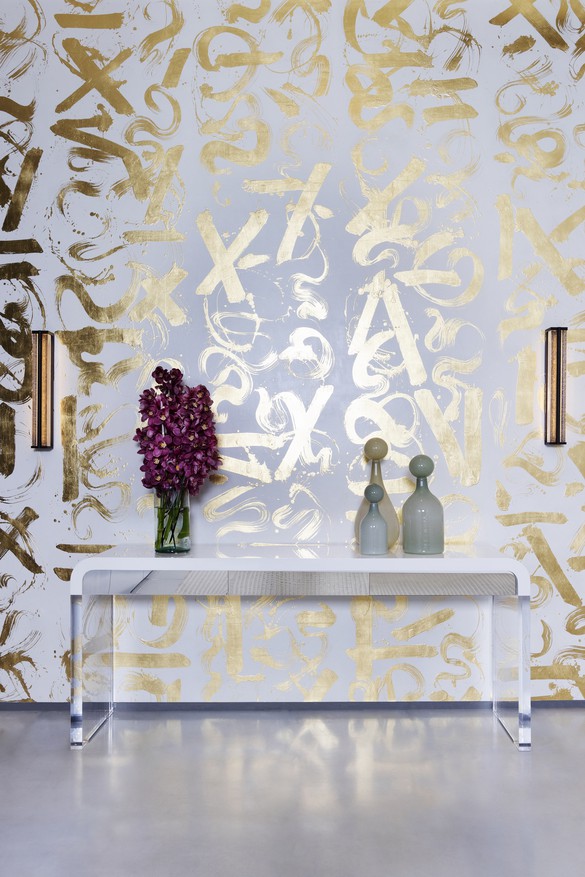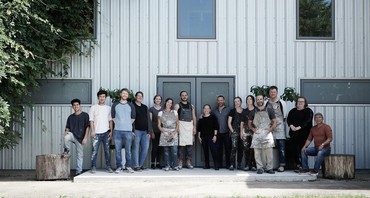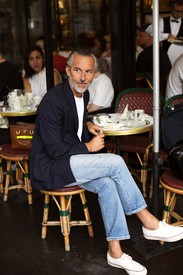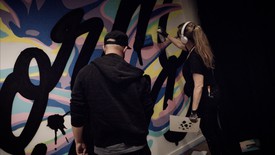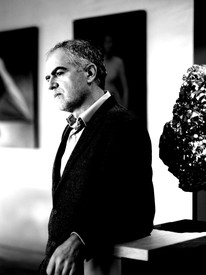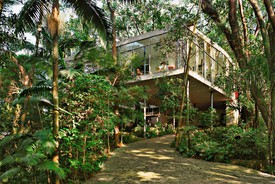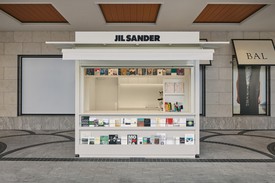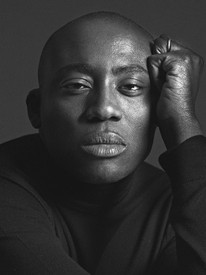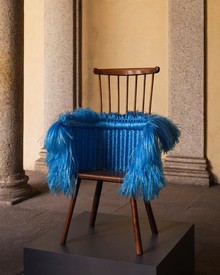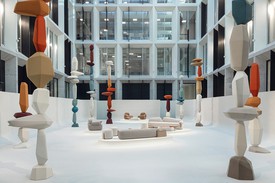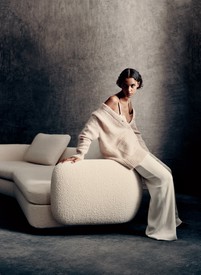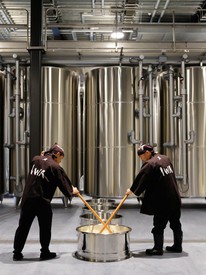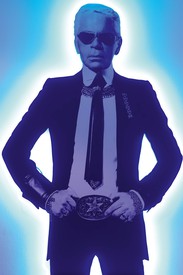
Wyatt Allgeier is a writer and an editor for Gagosian Quarterly. He lives and works in New York City.
Wyatt AllgeierCould you speak about your background? What drew you to the arts and design? What was going on before Assemblage, and what about that part of your life led you to this current journey?
Christian BatteauWe met at the Kansas City Art Institute in Missouri, and I was studying sculpture, and Heidi was focused on textiles and sculpture. We started collaborating there; she was knitting these beautiful structures, and I was helping her cast them in bronze. That was twenty-plus years ago—
Heidi BatteauYeah, it’s been a minute.
CBAnd we ended up together! And we decided to move to New York together after college. We both wanted to make fine art, and I wanted to launch a decorative plaster painting business in New York to support that.
HBThere are definitely more art-driven jobs in New York, so it seemed like a good fit for us. I worked in the textile industry, doing design for upholstery and wallcovering on a contract level, so hospitality, hotels, hospitals, that kind of thing.
CBThe decorative plaster painting was grueling work, in terms of scheduling, payment—service work is no easy task. So I started developing a lot of what I was doing on the wall into a product that could be produced on paper.
HBI was able to source a backing for the wallcovering from my background in contract textiles that he could use to put his materials on.
CBThat seed work really started in New York.
HBAnd while we were in New York in those industries, we were also always keeping a fine art studio.
WAWhat was the catalyst for your move from New York to Arkansas?
HBWe spent eight-plus years in New York and loved it, but our priorities were shifting toward starting a family and having more time in nature.
CBAnd this was around 2008, when it became a very tough time in the city due to the economy, and so it started making us question what we wanted to do with the rest of our lives. We had visited Heidi’s family here in the Ozarks a few times, and on one of those trips we found a 32-acre farm that was for sale and that set the dream in motion—we’re going to grow organic vegetables and make fine art . . .
HBIt’s very romantic.
WAI have this fantasy almost every day of my life. I totally get it [laughter].
Video: courtesy Assemblage
CBAnd soon thereafter we found this place and made the decision. We bought the farm; we rebuilt a little saltbox farmhouse and started the huge market garden and got a milk cow. And then all of the work that we had been establishing in New York followed us to the Ozarks, and we basically had to deconstruct our living room and create a wallpaper-manufacturing studio in the front half of the house.
HB We put a 30-foot table in where our living room would be and spent the next year doing a rollout for two luxury houses. There was a point where we just decided this was really what was sustaining us and funding the life here.
CBAnd so we bought a building on the highway not far from us that had been destroyed by a tornado and just went to town renovating it. We got a crew and started training folks, and then, in 2013, we officially incorporated as Assemblage.
HBAnd with each new project we would get, we would just put the money back into the building and the business.
WACan we talk about what the process for your designs is like? Do you start with drawings, or is it a client or mood—
HBSo many ways [laughs].
CBSometimes it is inspired by a collaboration with the client, definitely. They have a particular vision.
HBAnd they usually come to us because they understand our language, too, so there’s a reason why they’re here already.
CBAlso, a lot of what we make is either inspired by nature or comes out of a happy accident. Sometimes we take ancient patterns and deconstruct or reconstruct them.
HBAnd in nature, we spend a lot of time thinking through the patterns of bark, for instance, or the way reeds are lining up. The accident would be, like, something’s trapped under a paper. We are always playing with material, and then one day you see this beautiful explosion come through. That particular experience led to a paper we call Arashi.
CBWe love systematizing the happy accident. If you leave a trowel on wet material and pick it up, it leaves this beautiful shape that is almost reminiscent of nacre. And so we take that form and then figure out a way to repeat it and turn it into something that becomes seamless and can exist in a space.
WAIn terms of materials, how do you make decisions for the paper, the treatments, and so forth?
CBGenerally, like in art and probably in life, it is helpful to start with constraints or parameters, then take these disparate ideas or different materials and try to see how they could fit within those borders. So most of what we make is on a cellulose-based paper, and we start with marble-dust plaster. A lot of people know it as Venetian plaster. And we use the same tools, like trowels and blades, that people have used for thousands of years—they’re stainless steel now, but the same technique remains as a base. And then from there we say, okay, how do we fit palladium into this process?
HBOr abalone or mother-of-pearl. For us, always having a new challenge is key—it keeps it interesting and infuses the days with fun, with learning.
WAWhat do you think of as your target audience or your target customer? What do you hope they experience once it’s finally installed?
HBWarmth.
CBYeah, we want it to feel natural and warm. And when you’re asking about the materials, I think somebody who really appreciates the materials, somebody who appreciates marble plaster and knows what that is, and somebody who understands what pale gold is or understands that palladium is thirty times more rare than gold and really appreciates how beautiful that material is on the wall.
HBAnd appreciates the hand and maybe the accidents that happen in the hand—it may not be perfect, like machine-made, but there’s a beauty in that imperfectness.
CBIt’s better. It’s better than a machine because you have these humans who are master artists producing a thing that almost looks like the machine, except then you see these idiosyncratic moments. There will only be one group of papers like theirs. They’re distinct. They’re unique. And although they all match, they all have the hand of those artists imbued in the paper.
WACan you tell me about your team?
HBWe are so lucky.
CBExtremely. So the first person we hired—
HBWe found through Craigslist. I don’t know if that even is a thing—
CBEric came in as, like, a goof.
HBHe was like, this can’t be real, who’s making wallpaper in Arkansas?
CBAnd he’s amazing. He’s our head of production still today. That was twelve years ago.
HBHe already had an incredible attention to detail and was obviously very smart. But what’s nice is we were able to train—because we do unique things, because we use very special materials and do them in our own particular way—from the ground up. So now all these years later, he has trained a crew of twelve other people.
WAAnd how did your partnership with Holly Hunt come about?
HBThey first represented us in Dallas around 2014, then Houston. And then distribution was expanded across all markets by 2019.
CBWhat we noticed right off the bat, working with them in Dallas and Houston, was that we both had a very similar philosophy and approach to the world and to clients.
HBA deep appreciation for the artisan, for the handcrafted.
CBThe importance of kindness in the culture of the business, the focus on making something extraordinary. The fit was really great. And their incredible network for distribution meant that we could scale our business and still maintain the authenticity. They’ve really let us operate as we had from the beginning. When Heidi and I decided to focus our energies on wallpaper instead of fine art, we had these tenets: sustainability, treating our employees well by paying them well and by treating them with respect, and the absolute bottom line was the pursuit of making—
HBThe most beautiful thing we can make regardless of what that cost is.
Photos: courtesy Holly Hunt
